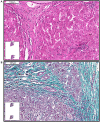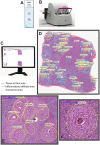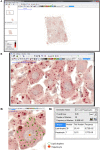Whole Slide Imaging and Its Applications to Histopathological Studies of Liver Disorders
- PMID: 31970160
- PMCID: PMC6960181
- DOI: 10.3389/fmed.2019.00310
Whole Slide Imaging and Its Applications to Histopathological Studies of Liver Disorders
Abstract
Histological analysis of hepatic tissue specimens is essential for evaluating the pathology of several liver disorders such as chronic liver diseases, hepatocellular carcinomas, liver steatosis, and infectious liver diseases. Manual examination of histological slides on the microscope is a classically used method to study these disorders. However, it is considered time-consuming, limited, and associated with intra- and inter-observer variability. Emerging technologies such as whole slide imaging (WSI), also termed virtual microscopy, have increasingly been used to improve the assessment of histological features with applications in both clinical and research laboratories. WSI enables the acquisition of the tissue morphology/pathology from glass slides and translates it into a digital form comparable to a conventional microscope, but with several advantages such as easy image accessibility and storage, portability, sharing, annotation, qualitative and quantitative image analysis, and use for educational purposes. WSI-generated images simultaneously provide high resolution and a wide field of observation that can cover the entire section, extending any single field of view. In this review, we summarize current knowledge on the application of WSI to histopathological analyses of liver disorders as well as to understand liver biology. We address how WSI may improve the assessment and quantification of multiple histological parameters in the liver, and help diagnose several hepatic conditions with important clinical implications. The WSI technical limitations are also discussed.
Keywords: digital pathology; digital slide; hepatic tissue; histology; histopathology; liver disorders; virtual microscopy; whole slide imaging.
Copyright © 2020 Melo, Raas, Palazzi, Neves, Malta and Silva.
Figures




Similar articles
-
Utility of whole slide imaging and virtual microscopy in prostate pathology.APMIS. 2012 Apr;120(4):298-304. doi: 10.1111/j.1600-0463.2011.02872.x. APMIS. 2012. PMID: 22429212 Review.
-
Evaluation of panoramic digital images using Panoptiq for frozen section diagnosis.J Pathol Inform. 2016 May 4;7:26. doi: 10.4103/2153-3539.181770. eCollection 2016. J Pathol Inform. 2016. PMID: 27217976 Free PMC article.
-
The histopathological diagnosis of atypical meningioma: glass slide versus whole slide imaging for grading assessment.Virchows Arch. 2021 Apr;478(4):747-756. doi: 10.1007/s00428-020-02988-1. Epub 2020 Dec 10. Virchows Arch. 2021. PMID: 33305338 Free PMC article.
-
Current Status of Whole-Slide Imaging in Education.Pathobiology. 2016;83(2-3):79-88. doi: 10.1159/000442391. Epub 2016 Apr 26. Pathobiology. 2016. PMID: 27101397 Review.
-
Applications and challenges of digital pathology and whole slide imaging.Biotech Histochem. 2015 Jul;90(5):341-7. doi: 10.3109/10520295.2015.1044566. Epub 2015 May 15. Biotech Histochem. 2015. PMID: 25978139 Review.
Cited by
-
Constructing a neural network model based on tumor-infiltrating lymphocytes (TILs) to predict the survival of hepatocellular carcinoma patients.PeerJ. 2025 Apr 23;13:e19351. doi: 10.7717/peerj.19351. eCollection 2025. PeerJ. 2025. PMID: 40292102 Free PMC article.
-
Comparative Analysis of Immunohistochemical Staining Intensity Determined by Light Microscopy, ImageJ and QuPath in Placental Hofbauer Cells.Acta Histochem Cytochem. 2021 Feb 25;54(1):21-29. doi: 10.1267/ahc.20-00032. Epub 2021 Feb 20. Acta Histochem Cytochem. 2021. PMID: 33731967 Free PMC article.
-
A major ecological niche of eosinophils in evolving Schistosoma granulomas challenges the eosinophil view as "helminth killer" cells.Sci Adv. 2025 Jun 13;11(24):eadt2779. doi: 10.1126/sciadv.adt2779. Epub 2025 Jun 11. Sci Adv. 2025. PMID: 40498832 Free PMC article.
-
A generalized deep learning framework for whole-slide image segmentation and analysis.Sci Rep. 2021 Jun 2;11(1):11579. doi: 10.1038/s41598-021-90444-8. Sci Rep. 2021. PMID: 34078928 Free PMC article.
-
Comparative Evaluation of Breast Ductal Carcinoma Grading: A Deep-Learning Model and General Pathologists' Assessment Approach.Diagnostics (Basel). 2023 Jul 10;13(14):2326. doi: 10.3390/diagnostics13142326. Diagnostics (Basel). 2023. PMID: 37510069 Free PMC article.
References
Publication types
LinkOut - more resources
Full Text Sources

